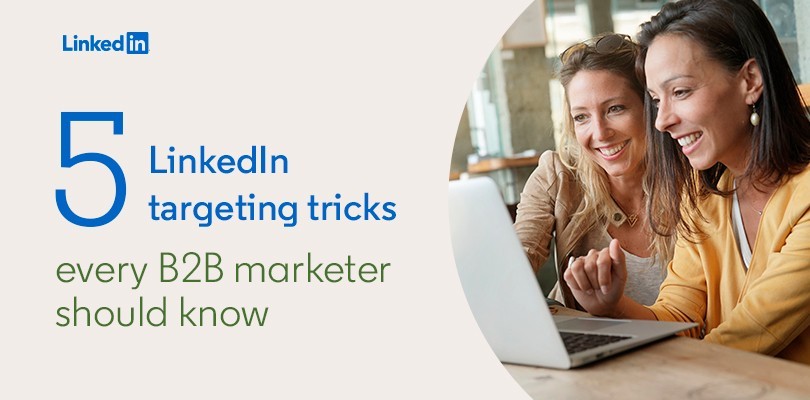Five LinkedIn targeting tips every B2B marketer should know
I’ve had a very busy four years working at LinkedIn, moving through three different roles supporting clients for our Marketing Solutions business. The scope of what I do, and what I help clients to do, has kept expanding. However, there’s been one constant theme throughout: effective use of LinkedIn targeting is absolutely essential to helping clients make the most of the opportunities on our platform. It’s the most important form of value that I add for them.
During my time here, I’ve had the opportunity to introduce marketers to new solutions like LinkedIn Lead Gen Forms, Account-Based Marketing (ABM) and Video for Sponsored Content. I’ve helped them leverage new formats and touchpoints on our platform to deliver against a range of marketing objectives. However, the first question I ask of those objectives has always been: what do they mean for the targeting strategy we should adopt?
As a Campaign Planner, I built target audiences for clients and put those audiences into a plan that they could leverage over the duration of their campaign. As a Campaign Manager I became a subject matter expert on building those campaigns, helping clients to optimise their targeting according to the results they needed. In my current role as a Senior Deal Desk Strategist I work with large enterprise clients to plan annual or ‘always on’ campaigns, which brings a whole new dimension to how you translate your available budget into the right targeting strategy.
In the course of those different roles, I’ve developed five principles for effective targeting on LinkedIn that I find myself applying to campaigns time and time again. These five principles often make a major difference to the Return on Investment (ROI) that a campaign can achieve. I wanted to take this opportunity to share them – five LinkedIn targeting tips that I believe every B2B marketer should know:
Tip 1: Start with objectives
Throughout my LinkedIn career, one of the most important pieces of advice I’ve been able to give is whether a particular targeting approach really aligns with an advertiser’s campaign objectives. I’ve been able to give my perspective on whether they are defining a broad enough audience to drive the awareness they need, for example, or how to balance cost-efficiency and precision when generating leads.
With the launch of the objective-based advertising experience through the LinkedIn Campaign Manager interface, advertisers have far more immediate insight to help check their targeting strategy. They no longer have to take my word on whether it aligns with the results they’re aiming for. Once you select an objective and set your targeting criteria in Campaign Manager, you’ll see a forecast of projected results based on the audience you’re likely to reach. This includes the most relevant metrics for your objective. If you’re focused on driving traffic or generating leads, you’ll be able to see the impact of your targeting on the volume of clicks and the cost per click (CPC), for example.
Tip 2: Personalise separate campaigns for decision-makers and influencers
When advertisers start to interrogate their targeting objectives, one of the first things they often realise is that they need to reach and engage several different audiences in order to achieve their goal.
B2B marketers need an influencer strategy when it comes to their campaign targeting. They know they need to target relevant decision-makers within a business, but they also need to reach all of those who will influence that eventual decision. Those influencers will occupy different roles in different functions. They could be end-users, members of the procurement team, C-suite executives, or other internal partners. The best approach is to build separate campaigns for the different personas, developing a targeting strategy for each. Those separate campaigns will then give you the opportunity to personalise your messaging and call out the specific part of the influencer audience that you’re addressing, in your creative.
Tip 3: Trust the ‘Fab Four’ core targeting facets
Once you’ve identified the personas you need to target, the big question is how to translate these into the right combination of targeting facets on LinkedIn. There are more than a dozen targeting categories to choose from, and the choice can seem bewildering. My experience has taught me though, that there are four core targeting criteria that are almost always the most effective and efficient way to define your audience. They are Seniority, Function, Industry and Company Size. Between them, they provide the best possible foundation for your targeting.
Using a combination of two or three of these core facets will typically result in an audience that’s both relevant and large enough for you to reach them efficiently. The Ad Operations team at LinkedIn has a mantra: “Go broad or go home.” It’s a rule I live by, because if the audience you target is too niche (less than 20,000 members), it can be quite difficult to serve enough impressions to have statistically relevant reporting.
Within the Fab Four core facets, Function and Seniority are a great combination to use, and they are usually far more effective than job titles when you are trying to target specific roles. Function is made up of standardised groupings of job titles, placing all marketing job titles into the marketing function, for example. It means you don’t miss out on reaching relevant members just because they have a slightly different job title to the one you were expecting.
Seniority is my ‘go-to’ facet, I use it with almost all my audiences because it can determine all levels of experience and tenure from entry level through to VP or Owner. This is particularly helpful when targeting an influencer community – since you know that a range of senior people within particular functions are likely to be involved.
I often find myself using Company Size and Industry together, to define specific audiences and ensure you are reaching them with the most relevant possible messaging. If you’re launching a new marketing automation solution, for example, you might well have a very different message for SMBs than you would for enterprise-level businesses.
The fact that I almost always start with the Fab Four doesn’t meant that the other targeting facets on LinkedIn aren’t relevant. Once you’ve launched an initial campaign, you can often use criteria like job title to optimise and refine your approach. If you find that you’re reaching a lot of people with a job title that you know isn’t relevant, for example, you can exclude that title from your campaign, optimise your approach, and still retain the scale that you need to be efficient.
Tip 4: Test different routes to the same target
Alternative targeting criteria really come into their own when you want to test different routes for reaching an audience. This is important because, when you define the impressions and the clicks that you want in the same way as most other marketers do, you find yourself competing with all of those other marketers when you bid for them. By AB testing different ways to target the same audience, you can find different routes, lower your bids and increase your ROI.
I’ve found that the best approach is to start with a broad audience using the core targeting facets – and then look carefully at the characteristics of those engaging with your campaign. If you find that a large proportion have the same job titles, then try defining the audience in terms of those job titles instead. If you see relevant skills consistently appearing, try building an alternative campaign using those. You’re still giving the same people the opportunity to engage – but you might need to bid significantly less in order to do so.
Tip 5: Go bespoke and get creative for additional targeting ROI
The final tip takes the principle of finding alternative routes to an audience to the next level – by leveraging the many different targeting methods now available on LinkedIn, besides LinkedIn profile data.
When you have your own relevant data available, building a bespoke targeting segment using that data will often help to lower your bids and increase your ROI. You can use email matching to translate an existing database into an audience on LinkedIn – or use account targeting to define a priority list of businesses you want to reach as part of an ABM strategy.
Targeting by interest provides another, potentially more efficient, route to your audience. It has the added advantage of picking up on signals of active intent, and reaching people who you didn’t know were involved in buying decisions. You can test targeting approaches that combine interest with other targeting criteria, to see if they deliver the combination of reach and relevance that suits your objectives.
Staying ahead of the targeting game
Developing new approaches to targeting on LinkedIn is one of the most exciting aspects of what I do. It helps clients to take advantage of new features and options as they’re introduced – and keep innovating to stay ahead of the game. Targeting on LinkedIn will always evolve. However, the principles of what makes an effective targeting strategy are very consistent. Focus on your objectives, start broad and refine based on data and experience – and don’t be afraid to test different routes to reaching the audience you need.
Related articles



